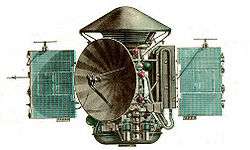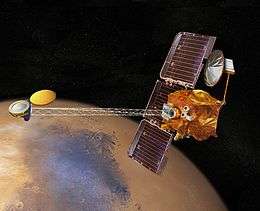Mars 4
| Mission type | Mars orbiter[1] |
|---|---|
| Operator | Lavochkin |
| COSPAR ID | 1973-047A[2] |
| SATCAT № | 6742[2] |
| Spacecraft properties | |
| Spacecraft | 3MS No.52S |
| Manufacturer | Lavochkin |
| Start of mission | |
| Launch date | 21 July 1973, 19:30:59 UTC[3] |
| Rocket | Proton-K/D |
| Launch site | Baikonur 81/23 |
| End of mission | |
| Last contact | 30 July 1973 |
| Orbital parameters | |
| Reference system | Heliocentric |
| Flyby of Mars (failed orbiter) | |
| Closest approach | 10 February 1974, 15:34 UTC |
| Distance | 1,844 km (1,146 mi) |
Mars 4 (Russian: Марс-4), also known as 3MS No.52S was a Soviet spacecraft intended to explore Mars. A 3MS spacecraft launched as part of the Mars programme, it was intended to enter orbit around Mars in 1974. However, computer problems prevented orbital insertion from occurring.
Spacecraft
The Mars 4 spacecraft carried an array of instruments to study Mars. In addition to cameras, it was equipped with a radio telescope, an IR radiometer, multiple photometers, polarimeters, a magnetometer, plasma traps, an electrostatic analyzer, a gamma-ray spectrometer, and a radio probe.[4]
Built by Lavochkin, Mars 4 was the first of two 3MS spacecraft launched to Mars in 1973, being followed by Mars 5. A 3MS was also launched during the 1971 launch window as Kosmos 419. However, due to a launch failure, it failed to depart Earth orbit. In addition to the orbiters, two 3MP lander missions, Mars 6 and Mars 7, were launched during the 1973 window.
Launch
Mars 4 was launched by a Proton-K carrier rocket, a Blok D upper stage, flying from Baikonur Cosmodrome Site 81/23.[3] The launch occurred at 19:30:59 UTC on 21 July 1973, with the first three stages placing the spacecraft and upper stage into a low Earth parking orbit before the Blok D fired to propel Mars 4 into heliocentric orbit bound for Mars.
Shortly after performing a course correction on 30 July 1973, two onboard computers failed, leaving Mars 4 unable to perform manoeuvres. As a result of this, it was unable to enter orbit around Mars. A small amount of data was returned as the probe flew past Mars on 10 February 1974, with a closest approach of 1,844 kilometres (1,146 mi) at 15:34 UTC.[4]
See also
References
- ↑ Krebs, Gunter. "Interplanetary Probes". Gunter's Space Page. Retrieved 12 April 2013.
- 1 2 "Mars 4". US National Space Science Data Centre. Retrieved 12 April 2013.
- 1 2 McDowell, Jonathan. "Launch Log". Jonathan's Space Page. Retrieved 12 April 2013.
- 1 2 Siddiqi, Asif A. (2002). "1973". Deep Space Chronicle: A Chronology of Deep Space and Planetary Probes 1958-2000 (PDF). Monographs in Aerospace History, No. 24. NASA History Office. pp. 101–106.


.jpg)
.jpg)